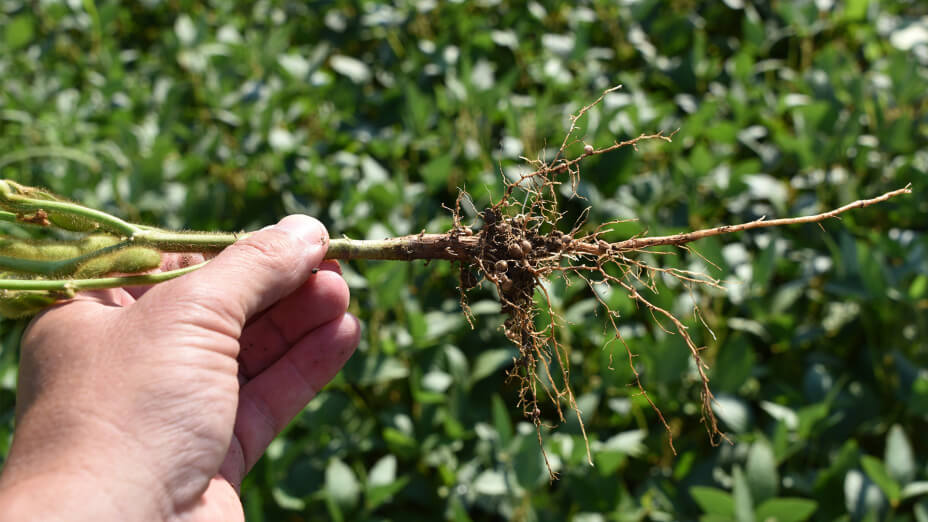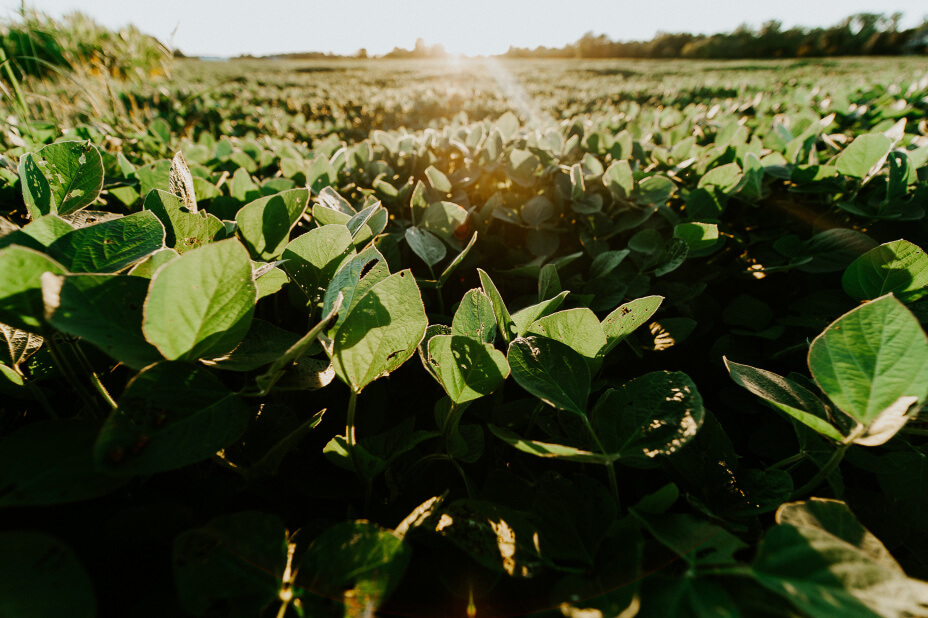Factors influencing soybean nodulation

What you'll learn:
Many factors, both environmental and man-made, can affect the level of rhizobial nodulation on soybeans
Nodulation is a natural process that is initiated by the plant through a complex signaling relationship with rhizobia
Because it is a natural process, the signaling events between the soybean plant and the rhizobia can become disrupted by several factors
Background
Nodulation generally begins about three to four weeks after emergence once the plant senses a need for nitrogen. The following factors can have a dramatic effect on the intensity, timing and efficiency of nodule development and nitrogen fixation. Taken alone, any one of the following factors can affect nodulation; however, it is common to find more than one factor influencing the extent of nodule formation on soybeans.
Soil chemistry and nutrients
As soil pH drops below 6, the conditions can become too acidic for rhizobia to effectively create nod factor and form nodules1. Rhizobia survival can also be affected. Important micronutrients, including molybdenum, that are cofactors for nitrogen fixation may become unavailable under low pH conditions.
Salt content in soil could be naturally occurring or due to irrigation. Introduction of salt can adversely affect nodulation even in concentrations low enough to allow for rhizobial survival and root colonization.
As carryover nitrogen levels in the soil rise above 40 lbs/acre, nodule formation is negatively affected2. If plants have a source of nitrogen readily available, there is no incentive to signal to rhizobia to form nodules and thus the rhizobia do not create nod factor. Once this carryover nitrogen is used up, the plant then may signal to the rhizobia, but the whole nodulation process then becomes delayed or the signaling window can be missed, resulting in little to no nodulation on the soybean plants.
Cultural and physical
Fields that have never been planted with soybeans have little to no rhizobia present, making natural inoculation/nodulation difficult. In general, the more times a field has been planted with soybeans with successful inoculation/nodulation, the higher the level of indigenous rhizobia. However, naturalized rhizobia may become less infective and/or effective over time and thus a supply of elite rhizobia, selected and fermented for these critical attributes.
Natural differences in soybean products can also affect the intensity of nodulation because soybean plants control the symbiotic nitrogen fixation process, and some soybean products perform this task more efficiently than others. In the absence of supplemental inoculation, there can be vast differences in presence of nodules between two given soybean products. These differences can be lessened by introducing elite strains of rhizobia into the environment to counter those variances.
Combining LCO with rhizobia increases the rate of early soybean nodulation, resulting in 2X as many nodules compared to rhizobia alone3. Both TagTeam® LCO XC and Optimize® XC technologies offer this effective combination.
Soil texture/organic matter can affect rhizobia populations. In general, the coarser the soil the less rhizobia can survive year to year, negatively affecting rhizobia populations and inoculation/nodulation. Sandy soils can also get extremely dry and hot, which cause the rhizobia populations to desiccate and decrease rapidly.
No-till conditions can create colder, wetter conditions early in the season, which can increase the stress levels of the plant, negatively affecting the signaling process between the plant and the rhizobia. These same conditions also can decrease the activity of the rhizobia, thus delaying nodulation.
Temperature and precipitation
The northern range of soybean-growing areas experience more extreme seasonal temperature fluctuations from colder winters to hot and dry summers, making it less likely that rhizobia can survive from year to year. The southern range of soybean-growing areas also can experience extremely high temperatures and dry conditions. In addition to creating plant stress, soil moisture can affect rhizobia survival. Hot, dry conditions can cause rhizobia desiccation and death, while flooding can create anaerobic conditions which cause rhizobial death due to low oxygen conditions.
In addition to creating plant stress, temperature extremes can have an effect on the efficacy of soil rhizobia. In temperatures below 50° F (10° C), rhizobia become mostly inactive and the nodulation signaling process can be interrupted4. In high temperatures above 90° F (32° C), especially when combined with dry conditions, rhizobial desiccation and death can occur5.
Biology
Often times, indigenous or native rhizobia will compete with the elite strains in an inoculant to occupy the infection sites on the soybean root. These native rhizobia may then infect and form nodules, but fix little to no nitrogen, making them parasitic to the soybean plants. The combination of LCO and rhizobia, delivered at the same time, which can be found in TagTeam® LCO XC and Optimize® technologies, can improve early nodulation by up to 2X.
Any practice that stresses the plant (disease, herbicide injury, nutrient deficiency/poor fertility, compaction, cold early season temperatures) reduces the ability of the plant to signal the rhizobia regarding its need for nitrogen, thus delaying nodulation.
Compounds applied to the seed and the soil such as incompatible pesticides, fertilizers and nutrients can cause rhizobial death. Care should be used with compounds such as talc (when applied during treating causes rapid rhizobial desiccation) or molybdenum (high toxicity) which can be incompatible with rhizobia. Always refer to published compatibility charts before using any unknown materials with rhizobia inoculants.
Novozymes BioAg products can help
The Novozymes® BioAg line of single-, dual- and triple-action inoculants help enhance the nodulation process. These products make the crucial pieces of the nodulation process available even in cases of environmental stress when they cannot be produced naturally. The unique properties available in products such as TagTeam® LCO, Optimize® XC and Cell-Tech® technologies can help soybean plants mitigate many of the stress factors they face.
The nodulation factors delivered in products like TagTeam LCO and Optimize support the nodulation process, overcoming stresses (e.g., low pH conditions, cold, tillage) to support productive nodulation. In cases of flooding and soil toxicity (e.g., salt and pesticide carryover), the supply of healthy rhizobia in these products or our single action inoculant Cell-Tech products support quick and effective nodulation.
In conclusion, by using products from Novozymes BioAg, you can maximize opportunities for successful initiation of nitrogen-fixing nodules.

Sources:
1 Pedersen, P. 2015. When do we need to inoculate our soybean seeds? Integrated Crop Management. Iowa State University. Paper 1559.
2 Staton, M. 2014. Identify- ing and responding to soybean inoculation failures. Michigan State University.
3 Based on a 2016 growth chamber trial.
4 Bohner, H. 2014. Cold temperatures hamper soybean nodulation. Crop Talk. OMAFRA.
5 Yadav, A.S. and Nehra, K. 2013. Selection/isolation of high temperature tolerant strains of Rhizobium for management of high temperature stress on Rhizobium — legume symbiosis. International Journal of Microbial Resource Technology. Vol. 2:47-57.
Your innovation partner
Our commitment to innovation has helped us develop the world’s leading microbial inoculant, biostimulant and biocontrol solutions portfolio.
By partnering with us, you could make that commitment work for your business.
- Investment, with around 14% of our revenue going towards research and development
- Vertical integration from discovery to production. That leads to close cooperation between our R&D and commercial teams
- A global presence, with fermentation facilities across the globe ensuring that you can trust us to deliver on time
- World-leading formulation technologies that promote homogeneity and stability in our products